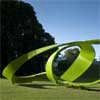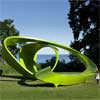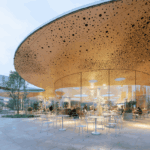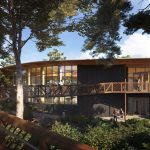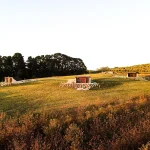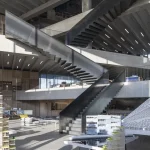Learning from Nature Pavilion, Danish Building, Project, Photo, Design, Image
Learning from Nature Pavilion
3XN Pavilion in Denmark : Architecture Information
15 Feb 2010
Learning from Nature
3XN showcase pavilion
‘Learning from Nature’, Louisiana Museum of Modern Art, Denmark
Louisiana Pavilion : International Innovation Award
The green Pavilion in the Sculpture Park of the Louisiana Museum of Modern Art has been a catalyst for play and energy during the past few months. The pavilion has now been honoured with the JEC Innovation Award 2010 for its design combining sustainability and intelligent materials
25 Jun 2009
Self-cleaning surfaces, phase changing materials and built-in sensors that generate energy from the footsteps of the visitors. The 3XN pavilion ‘Learning from Nature’ unites the most advanced technologies and intelligent materials in a preview of the innovative architectural design of tomorrow.
The Louisiana Museum of Modern Art invited the Danish architecture firm 3XN to design a pavilion demonstrating cutting edge possibilities within sustainable and intelligent materials. The result is a pavilion that is built of bio composites with integrated intelligence that creates a dynamic interaction with its physical surroundings and its users.
Sustainability does not equal architectural compromise
The pavilion is called ‘Learning from Nature’ and everything about the pavilion is literally inspired by nature itself: The biological cycle of nature is the fundamental basis for the shape, the materials and the dynamic energy generation. The pavilion is shaped as a Moebius band to symbolize the biological cycle; and the properties of the construction are very like those of nature – for example, the pavilion has a coating of nanoparticles that helps clean the surfaces and clean the air. Additionally, the pavilion is built of biodegradable materials; and as for energy, the pavilion is 100 percent self-sufficient.
Kim Herforth Nielsen, Principal of 3XN, comments on the project:
– The Pavilion has given us the opportunity to showcase the possibilities which exist in building with sustainable and intelligent materials. Our objective has been to show that Green Architecture can be dynamic and active. We often think that we need to minimize use of resources at all costs. Instead of focusing on consuming the least amount of energy, we need to focus on producing and using energy and materials in a more intelligent way than is the case today.
The development of the pavilion is a natural continuation of 3XNs extensive focus on new technologies and materials; a focus that led to the establishment of a unique in-house Research & Development unit in 2007. Since then, 3XN has built an international reputation as one of the most visionary and ambitious architecture firms in the field.
‘Learning from Nature’ is unveiled today and can be seen at the Louisiana Museum of Modern Art, Denmark, until October.
Louisiana Museum of Modern Art
Louisiana Museum of Modern Art Exhibition : Green Architecture for the Future
3XN’s LOUISIANA PAVILION
As part of the ‘Green Architecture for the Future’ architectural exhibition, the Louisiana Museum of Modern Art invited 3XN to design a pavilion demonstrating cutting edge possibilities with sustainable and intelligent materials.
The Pavilion has given us the opportunity to showcase the possibilities which exist in building with sustainable and intelligent materials. Our objective has been to show that Green Architecture can be dynamic and active. We often think that we need to minimize use of resources at all costs. Instead of focusing on consuming the least amount of energy, we need to focus on producing and using energy and materials in a more intelligent way than is the case today, says Kim Herforth Nielsen, Founder and Principal architect of 3XN.
The vision of the project has been to build with biodegradable and energy-generating materials, creating an energy-self-sufficient architecture that also can be part of, and be decomposed in, the biological cycle after use.
New Combinations
Sustainable solutions are often associated with architectural compromises. For this reason it has been important to show that sustainable materials have legitimate future potential in the building industry – practically as well as aesthetically. Building with intelligent and biological materials with a refined finish, in a complex mode of expression, pushes the limit in people’s minds of what is obtainable with sustainable materials today.
Sustainable Materials
Well-known synthetic products have been substituted with biological and reusable materials. For the outer shell of the sculpture, glass fiber composites have been substituted with a bio composite from flax fibers cast in biological resin. Cork sheets replace polystyrene foam for the inner core.
Intelligent Materials
For the sculpture, the newest built-in technologies have been applied creating a dynamic and green architecture. On the top face of the pavilion, 1mm flexible solar cells are placed. The cells are cast in thin film making them applicable to double curved surfaces. Piezoelectric materials that generate an electric current from the weight of the visitors are laid in the floor. Combined, this makes the sculpture self-sufficient with energy to power the integrated LED lights.
“Why not build dynamic buildings that harvest energy from the surroundings?”
The pavilion has a coating of nanoparticles that makes the surfaces self-cleaning. Due to a hydrophilic nanostructure, rain water is dispersed beneath the dirt on the surface, leaving it cleaner. A second coating adds air cleaning properties to the pavilion. A chemical process called photocatalysis decomposes up to 70 percent of pollutants from industrial smog. Documentation shows that the air quality is improved within an 8-feet radius of air cleaning surfaces.
The pavilion retains heat by using phase changing materials. Heated by the sun, the material retains the energy, releasing it again when the temperature drops. At exactly 23 degrees Celsius, the material changes from a solid to a liquid form. When the temperature rises, the material absorbs energy and is liquefied. When the temperature drops, it solidifies and releases energy. In other words, the surface of the pavilion remains cooler when the temperature of the surroundings is rising, and vice versa. It is estimated that phase changing materials can cut costs with 10 to 15 percent on heating and cooling of buildings.
Digital Design and Production
The design of the pavilion is optimized according to function and material consumption. The mode of expression and material consumption is digitally designed to meet the exact needs, i.e. 14 layers of fiber and 84mm of cork are specifically designed to meet the dynamic forces arising from wind load and the load from people walking on the surface. Adapting the new sustainable materials to the digital modes of production has been a huge challenge in itself. The learning process of substituting synthetic materials for biological counterparts has spanned the entire project phase, revealing many obstacles and given rise to new innovations on the way.
Process
The Louisiana Pavilion is a joint venture of 20 companies. Due to a tight 4-month schedule and a high level of ambition, it was essential that all parties involved took ownership of the project; that concept, design, innovation and production were all in play at the same time during the development phase – a process where several project phases melted into one. This called for close, integrated cooperation between everyone involved.
The Design Team
Participating from 3XN was: Kim Herforth Nielsen, Kasper Guldager Jørgensen, Rasmus Møller, Christian Bundegaard, Stian Lenes and Morten Myrup.
Learning from Nature Pavilion – Project Partners
3XN – architects and project management
COWI – engineering and light design
Stage One Freeform Composites – production and installation
BASF, the chemical company – phase changing materials
Ashland Inc. – producer of bioresin
Amorim Cork Composites – producer of cork
Libeco-Lagae – producer of natural fibers
Flex Cell – producer of flexible photovoltaic
Noliac Motion – producer of piezoelectric materials
Nano-X GmbH – self-cleaning surface coatings
Phillips – producer of LED light
3M – structural tape
Micronal PCM©, climate control – phase changing materials
Optima Projects Limited – composite consultant
NetComposites Ltd. – network within composites
Scenetek – installation of electrical components
Danish Technological Institute – self-cleaning counseling
Risø National Laboratory DTU – Composite testing
Learning from Nature Pavilion images / information from 3XN Architects
Location:Copenhagen
Copenhagen Architecture
Copenhagen Architectural Designs – chronological list
Danish Architecture Walking Tours
Copenhagen Building News – Selection
Bellahoj Swim Stadium, Copenhagen : Arkitema Architects

picture from architect
Northern Harbour Copenhagen : COBE + SLETH MODERNISM, Polyform, Rambøll

image : COBE, SLETH MODERNISM, Polyform and Rambøll
Danish Buildings by 3XN – Selection
Comments / photos for the Learning from Nature Pavilion Copenhagen Architecture page welcome
Learning from Nature Pavilion Building

